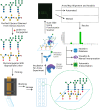Tools for generating and analyzing glycan microarray data
- PMID: 32983270
- PMCID: PMC7492694
- DOI: 10.3762/bjoc.16.187
Tools for generating and analyzing glycan microarray data
Abstract
Glycans are one of the major biological polymers found in the mammalian body. They play a vital role in a number of physiologic and pathologic conditions. Glycan microarrays allow a plethora of information to be obtained on protein-glycan binding interactions. In this review, we describe the intricacies of the generation of glycan microarray data and the experimental methods for studying binding. We highlight the importance of this knowledge before moving on to the data analysis. We then highlight a number of tools for the analysis of glycan microarray data such as data repositories, data visualization and manual analysis tools, automated analysis tools and structural informatics tools.
Keywords: data analysis; glycan binding; glycan microarray; glycomics; informatics.
Copyright © 2020, Mehta et al.; licensee Beilstein-Institut.
Figures




References
-
- Colley K J, Varki A, Kinoshita T. Cellular Organization of Glycosylation. In: Varki A, Cummings R D, Esko J D, et al., editors. Essentials of Glycobiology. Cold Spring Harbor, NY, U.S.A.: Cold Spring Harbor Laboratory Press; 2015. pp. 41–49.
Publication types
Grants and funding
LinkOut - more resources
Full Text Sources
